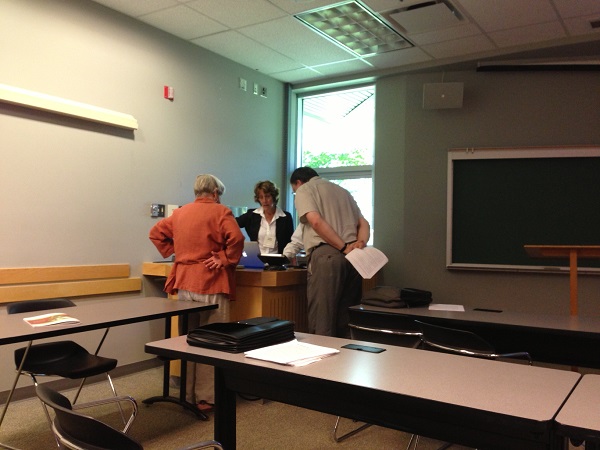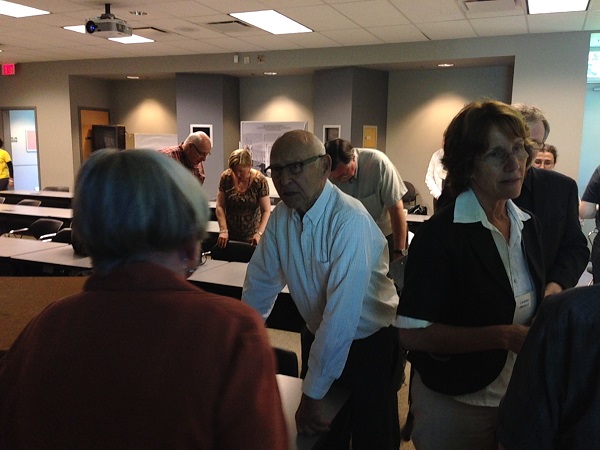Randip Bakshi http://www.twitter.com/randipbakshi
The panelists setting up as the session chair looks on. (Featured: John Osborne, Erica Dodd, and Lesley Jessop)
Monday afternoon's session on Painting and Sculpture noted John Osborne, President of the Canadian Society of Medievalists, was a "truly UVic panel" as all of the presenters were affilaited with the University of Victoria. Now this in itself is a compelling point when it comes to medieval art historical scholarship in Canada but we'll get to that momentarily. The panel's three presenters are trained art historians and include Lesley Jessop, Sessional Instructor at the Department of History in Art, Joseph Polzer, Associate Fellow at the Centre for Studies in Religion and Society, and finally, Erica C. Dodd, Adjunct Professor at the Department of History in Art and Emeritus Fellow at the Centre for Studies in Religion and Society. A well composed and thoughtfully selected panel, it had many overlapping themes but each of the panelists had a distinct argument.
In "Images at the Edge: Bas-Reliefs on the South Transcept at the Cathedral of Notre Dame, Paris", Lesley Jessop sugests that the previously identified cycle of the daily life of students is in fact a series of four reliefs illustrating members of the sewing guild. The set of images is on either end of the door, situating them quite literally, and perhaps very aptly, at the edge. The marginal profession, the author argues, is no longer in a marginal position because of the prominent placement of the reliefs. The many symbolic nuances of medieval art were well illustrated by the author such as lions, dogs, the wild man, and the nude man, which take up considerable space in the iconographic program. Moreover, the paper reflected on the "two worlds" inhabited by these images, the "real" and the "imagined."
In conclusion: The panelists catching up with each other. In the background can be seen Catherine Harding, Chair, Department of History in Art and PhD Candidate Brian Pollick. In the front are Erica Dodd, Joseph Polzer, and Lesley Jessop.
This was followed by a long and well-researched paper on Buffalmaco's Inferno in the Campo Santo in Pisa. John Polzer, an IFA (NYU) graduate, ably demonstrated the rigourous and exacting nature of scholarship that can only be expected from a previous generation of scholars. In a style reminiscent of only his generation, Polzer spoke at length about the concern with mortal evil in early Italian painting especially drawing upon Dante's Divine Comedy. He argues that the size of the inferno is almost three-quarters of the entire painting - in some places virtually as large as the Last Judgment - and must have had some significance in its portrayal. The obsession with depicticng the seven sins, the diversity of punishments, the seven layers of Hell, are all juxtaposed with Dante's descriptions of the former. He also points out that certain aspects of the painting relate to Dante's version and some do not (a point correctly noted by an observer as well). Polzer's command of his subject is remarkable with no written draft and hardly any notes to read from. His concluding image showed a rather mutilated (Prophet) Muhammad and the fate awaiting all infidels.
At this apt conclusion Erica Dodd begins her paper on medieval Syrian Christian paintings. Dodd's paper was on point, and as only a scholar of exacting standards can, she took control of the stage as soon as she started speaking. In the little time afforded she illustrated the importance of early Christian iconography in Syria, and by extension, the Middle East suggesting that Syria has a long presence in the both the region and in medieval art. Her motivation, to some extent, was the current turmoil and upheavel in Syria, one that was seen by her firsthand on her original visit to Mar Musa el-Habashi. She recounts the original state of the paintings when she found them and their later altered and currently extant versions under the restoration efforts of Italian priest Paolo del Oglio (1994). So, why are these painting important? As Dodd points out, they are the the only surviving cycle of images from the Crusader period in the Levant. Allowing scholars and researchers to better compare and contrast the similarities between and with the style at Jerusalem. An altogether entertaining and enthusiatic speaker Dodd related her paper with that of Polzer's by including the representation of the seven deadly sins albeit in an Eastern style, far removed from the Renaissance perfection of the Campo Santo.
These three papers and the current state of scholarship in Medieval Studies suggests the importance of visual culture in the making and unmaking of the Middle Ages. It also illustrates the considerable strengths of the Department of History in Art at the University of Victoria. With two dedicated Early Modernists (Italy/Europe), two leading Medieval Islamicists (Arab World and Levant/Safavi Iran and Mughal India), and a Byzantinist (Byzantine and Ottoman Empires) the Medieval Studies program is thriving and will continue to do so. This year the CSM had two panels on visual culture; perhaps, in coming years, all panels will feature papers with an art history component. Till then, let us hope this trend continues.


